Introducing the latest myCWT product and service enhancements
Building on our digital, omnichannel myCWT platform, our new products and services will simplify travel management for you and your employees – anytime, anywhere, anyhow.
Note: Featured services may not be available in your country at this time. Please reach out to your CWT representative for more details.
Hear from Chief Product Officer, Erica Antony as she shares the key product highlights of 2024, along with the key areas driving innovation.
-

2040: Baseline, Boom or Bust
As we enter an era of rapid transformation and unprecedented challenges, it is essential for travel managers, meeting & event planners, and corporate decision-makers to look ahead and frame our current strategic thinking with a clear vision of the future. Business travel and meetings and events (M&E) are poised for significant change over the next decade and a half, driven by a complex interplay of sustainability goals, technological advancements, evolving work models, and geopolitical dynamics.
In this paper to mark the 10th anniversary of our Global Business Travel Forecast, we explore, for the first time, a long-term vision of the future and potential trajectories through three distinct scenarios, each offering insights into how these forces should affect policy-making, budgeting and priorities. By examining these scenarios, we can better understand the diverse possibilities that lie ahead and the strategic imperatives required to thrive in each potential future.
Based on trajectory data analysis and interviews with industry leaders, behaviorists and climate tech founders, this forward-looking approach enables us to anticipate changes, strengthen our strategies, and make informed decisions that align long-term objectives. It is through this lens of foresight and adaptability that we can build resilience, seize opportunities, and navigate the complexities of the future.
We invite you to reflect on the insights presented, and consider how your organization can prepare for the opportunities and challenges that lie ahead. Together we can ensure that travel and meetings remain catalysts for growth, scalability and sustainable practices.
- Scenario development is both an art and a science
- Megatrends Shaping the Future of Business Travel, Meetings and Events
- Sustainability goals the new crux of corporate policy
- Technology Revolutionizes Travel Management
- Modern work models spark new travel patterns
- Changing demographics open doors to new opportunities
- Three Scenarios: Base case, boom and bust
- Future-proofing strategies

-

CWT GBTA Global business travel forecast 2025
When it comes to pricing, global business travel has finally reached an enduring, higher baseline. Prices will continue to rise in 2025, but only moderately, so expect a period of normalized growth.
However, this pricing environment, one of marginal gains and price regularity, is fragile. Global leisure travel has now realized a lot of its pent-up demand, while corporate travel has been resurgent, with 2024 edging at preCovid levels.
There are many factors at play, whether its volatile oil prices, labor costs and constraints, inflationary pressures, and geopolitical factors. As this elevated baseline edges upwards, albeit marginally, travel budgets will come under increased scrutiny, especially as travel patterns and attitudes change.
It’s why business travel can’t be viewed in a silo, and the true value to an organization must be fully realized. This forecast can help with those calculations.

-

Capitalize on emerging technologies in corporate travel
Technological advancements are accelerating at an unprecedented pace. How will emerging innovations like Generative AI, blockchain, and self-sovereign identity (SSI) transform corporate travel?
BTN and CWT probed global CEOs, travel managers, industry consultants and tech experts on the promises, questions, and expectations these innovations raise and how they are set to reshape traveler experience, cost control and service delivery in corporate travel and events.
Download and discover
- The technologies that will have the greatest impact on corporate travel in the next 2-5 years
- How these emerging technologies are poised to control costs, enhance service and security, and boost efficiency
- The critical challenges, opportunities, risks and roadblocks each innovation raises
- What travel managers, buyers and experts anticipate from these innovations

-

Spoiled for choice: How to pick the right technology for your corporate meeting program
Technology has undoubtedly improved our lives, allowing us to perform tasks more quickly and efficiently, and with greater ease. But not all technology is created equal. Some platforms promise better functionality, others seduce us with naturally intuitive interfaces.
Ultimately technology – whatever its level of sophistication or range of capabilities – is only effective if it produces the desired results. A firm must choose the right technology — one that most harmoniously synchs with its needs — not simply opt for the latest product on the market or the one used by all its competitors.
When we talk about meetings technology, some corporates tend to immediately start looking at what others are using. Rather than be stuck on that idea, we advise clients to look inwards. The first thing to do is not look at other companies, but to look at yourselves. It’s a discovery process. What do you require from the meeting technology? What is the objective of implementing such a technology, and based on that, we consider the proper fit?
Here are five things to consider when looking for technology that’s the best fit for your meetings program.
- Does it work across regions?
Consider technology that can be deployed across various markets and regions, not just dedicated to a single market. For instance some platforms in China are built to focus solely on China, not beyond, so certain meeting functionalities like sourcing and reporting might only be customized within the country. For domestic meetings this doesn’t pose an issue, but when a planner in China engages that technology to source hotels outside China, it has its limitations. Can the technology support multiple languages, does it include inventory across different regions? If not, don’t use it. - Is it multi-purpose?
Some companies will use specific programs for a one-off task, like sourcing. This will address any immediate concerns, but this silo method could prove to be limiting. Down the road, a firm may need to expand its scope to find a program that can fulfill multiple applications. Take the technology that you use for sourcing, for the specific function that currently serves your needs. Is it scalable? Can it be expanded for budgeting, registration or attendee management in the future? Some platforms are seamlessly holistic, allowing the planner to register a meeting, input budgets, source suppliers, track delegates, and offer a true end-to-end service that streamlines the entire process. Seek these out. - What data does it capture?
Data is digital gold, so no wonder that scouring it is called ‘mining.’ Companies need to choose technology that has strong reporting capabilities, that offers full tracking of data collected during a meeting, and can analyze and provide strategic insights into the information compiled. Data needs to be output into categories that are useful to a company’s custom requirements, which could range from the distribution of the meeting spend to where most of the meetings are held, from which hotels are used most frequently to the budget range across markets. These parameters will help an organization to understand the finer details of its meetings spend, allow it to identify patterns, and enable it to exercise better management and achieve better value and cost leverage. And that’s priceless. - Is it easy to use?
Let’s not sugarcoat the truth — inputting data can sometimes be considered a rather mind-numbing, thankless task. Using a system that makes the process instinctively straightforward certainly makes the burden easier to shoulder. Some organizations leave it to their agencies to input data. For those that opt to do it themselves, it is imperative to ask pointed questions of any client-facing interface. How many steps does it take to complete an entry? Do these steps take a lot of time? Is the information structured clearly and are the procedures intuitive to follow? How does the whole process flow or are there breakages in that flow? The best technologies, usually developed by established, matured providers, offer customization, so meeting planners can enjoy a system that is entirely shaped by their needs, all but guaranteeing its ease of use. - Try it before you buy it
Before committing to a specific type of technology, it’s vital to carefully evaluate what you’ll need from it. Some meeting technology offers better, more focused search functionality. Others are more intuitive in analyzing inputs and matching and predicting user requirements. Some allow search fields to be more extensive so that a customer can anticipate stronger, almost ‘customized’ matches. Then there are the types that provide results within a few short steps, ensuring you spend less time in the finding mode. Whichever facet of the technology is most important to you, it’s safer to test the search results during the exploration and testing stage of that technology, not after you’ve already sunk vast sums and inked an agreement to use it.
A version of this article was published on CEI Asia
- Does it work across regions?
-

Average ticket price for air bookings expected to fall 4% by April: CWT Solutions Group
CWT Solutions Group, the consulting arm of CWT, the B2B4E travel management platform, forecasts global average ticket prices (ATP) for air bookings will drop to around US$673 by April, down just over 4% from February levels, as published fares correct from the sharp increase seen in the first two months of the year.
These findings are published in the third edition of its bi-monthly Air Trends Report, which uses a proprietary algorithm to predict changes.
The global ATP climbed approximately 6% month-on-month in January, and then a further 3% in February, to reach US$702. This was largely the result of airlines across the globe implementing new commercial policies and revenue management models, which pushed up airfares.
“We foresee a continued upward trend in the average ticket price through 2019,” said Christophe Renard, Vice President of CWT Solutions Group. “One of the reasons is that more airlines are looking to adopt IATA’s New Distribution Capability (NDC) standard as a means to generate greater ancillary revenues such as seat selection and baggage fees. Post-booking price tracking tools can be an effective way for companies to optimize the cost of expensive tickets before upcoming departures.”
Meanwhile, the usage of Online Booking Tools (OBTs) continues to gradually increase as the main OBT providers continue to improve the user experience, especially on mobile apps. Efforts are also being made to improve the content available through these channels. At the same time, corporate travel management teams are encouraging their travelers to book through OBTs and mobile apps.
OBT usage was stable at around 48% globally in January and February, after a 6% increase from October to December. It is forecast to rise again in March and April, with more than 50% of all bookings expected to be made through OBTs for the first time ever.
The report also predicts that travelers’ advance purchase behavior will worsen in over the next two months. Stricter enforcement of travel policies as a result of year-end budget considerations and belt-tightening saw improved advance purchase behavior in December, and this carried over to January and February – with around 47% of tickets booked more than 14 days prior to departure. With companies now relaxing travel restrictions, this is expected fall to 43% in March and April.
“In order to keep a handle on costs, travel managers are advised to stress the importance of booking in advance, either as a message displayed on the OBT or through targeted communications to individual travelers,” said Renard. “It’s also important to ensure that OBTs are properly set up to reflect the organization’s travel policy, or to configure these tools with bespoke settings for each market.”
CWT is a leading global partner in business travel, meetings, and events. Operating across six continents, we deliver sustainable, tailored solutions that help organizations connect, engage, and thrive in an evolving world. Our myCWT platform integrates advanced technology with human expertise to simplify travel and enhance traveler and attendee experiences. Extensive global coverage, seamless data integration, AI-driven analytics, and carbon-conscious travel tools enable businesses to optimize their travel and meetings programs while delivering measurable value.
With 150 years of industry experience and a deep commitment to partnership, CWT collaborates with clients to shape the future of business travel and events, making them more efficient, responsible, and impactful.
-

International Women’s Day 2019 – Putting the spotlight on our CWT M&E women
We are joining in the world’s celebration of women, this International’s Women’s Day. Moving a step forward to achieving gender-equality, and empowering more and more women in their work-place. Here, at CWT Meetings & Events, we are so proud to support the movement and extend our heartfelt thanks to our global, ethnically diverse group of ladies, each contributing something special to our company. After all, who runs the world? In the famous words of pop powerhouse, Beyoncé.
This year, we’re doing something a little different. We are putting the spotlight on our special ladies, who truly make a difference. We want to showcase their stories. What is it like to be a women in the meetings & events industry? What empowers you most? We are sharing unheard stories of our incredible women:

“I am thrilled to see that our M&E industry today has more female representation, especially in senior roles, more than ever before. Within our own organization we have incredible examples of women absolutely exceeding in the meetings and events industry, every day. These female role models are driving the vision for our sector, and are carving a path for women like me to succeed tomorrow. We are fortunate to have a strong female demographic in our industry and as a woman in M&E with high aspirations, I am excited to see what ceilings are being broken today to support us all in our attempts at future success.” – Amy, Strategic Solutions Manager

“I love being a part of the meetings and events industry, it can be a challenge at times, but overall it makes me happy. As someone who is a perfectionist, it allows meto focus on all the details, unlike other industries. Your time and effort is valued by clients, and I get the chance to be a part of the bigger picture, creating unforgettable moments, and witnessing emotions – it is so empowering and inspiring.” – Anna, Co-head of CWT Meeting & Events, Ukraine
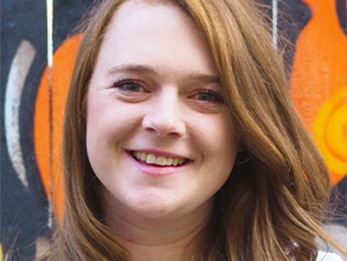
“Being a woman in the events industry means a lot, especially as it is female dominated. There is no discrimination or sexism. There is every type of woman in various kinds of role, whether than be operational, admin focused or finance specific. It’s so great to work in a friendly, welcoming environment, where you get to meet new people all the time, at networking events, on FAM trips or at award ceremonies, building a long term professional relationship.” – Jessica, Venue Sourcing Specialist
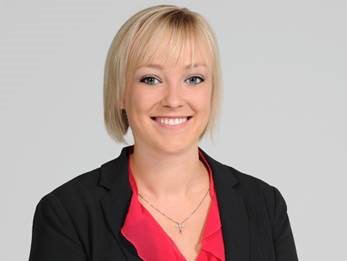
“The meetings and events field is dominated by women, who can empower each other to be the best version of ourselves, and others to achieve their best. As someone that has been in the industry for over eight years, I have a strong passion for creating life-long memorable events. Especially when attendees leave feeling connected, motivated and energized, along with a plan of action to keep the momentum going. It is all about making connections around the world, virtually too, which is a great way to connect people.” – Chelsea, Marketing Manager
We are very fortunate to have such a strong group of women working for us, and these are only a handful of them, across the globe. We feel strongly about creating a place of work that is both accepting and showcases equality to all our staff.
Wishing all our CWT meetings and events, clients and suppliers, a very happy International Women’s Day.
#balanceforbetter
-

Celebrating women’s day all year round
In the past years we have witnessed a positive change in ideas about women’s equality however the road to achieving it is still long. While governments and civil society have a key role to play, companies are a formidable force to advance gender equality by integrating women’s empowerment into corporate strategy.
This is why, at CWT, we support, endorse, and adhere to the UN’s Women’s Empowerment Principles (WEPs), and actively promote their engagement and adherence throughout our company – from the Chair downwards. This joint initiative of UN Women and the UN Global Compact provides a set of rules for companies, offering guidance on how to empower women in the workplace, marketplace, and community.
So, why not join us in celebrating International Women’s Day today and all year round, by following the seven WEPs:
- Establish high-level corporate leadership for gender equality.
- Treat all women and men fairly at work – respect and support human rights and non-discrimination.
- Ensure the health, safety and well-being of all women and men workers.
- Promote education, training and professional development for women.
- Implement enterprise development, supply chain and marketing practices that empower women.
- Promote equality through community initiatives and advocacy.
- Measure and publicly report on progress to achieve gender equality.
And, maybe add your own extra measures to the mix, such as:
- Encourage your leadership team to sign the principles.
- Post them online in your intranet and create an electronic form so all your employees can sign them.
- Initiate a task force to coordinate gender equality companywide.
- Consistently follow a written policy – reinforcing training and communication around it.
By taking concrete actions to reinforce gender equality further, you will make your company even more competitive, meet your CSR commitments, provide greater economic and social opportunities for both women and men, and foster sustainable development in the countries where you operate.
So let’s all #BalanceForBetter – not just today, but every day.
-

Here’s how to ‘KonMari’ your business travel
Japanese organizing consultant Marie Kondo has become something of a sensation since scoring her own Netflix series. But does her methodical approach to cleaning a house hold any lessons for bleary-eyed travelers?
You don’t have to thank the airport terminal, and let’s face it, business travel doesn’t always ‘spark joy’. But a little organizing now, possibly even before you have a trip planned, can make things a lot easier once you head to the airport.
- Pack a gadget bag
Why all countries haven’t been able to reach a consensus on a single type of plug remains a real head-scratcher. Apparently, there are around 15 different types of plugs in use today. This socket inconsistency can be one of the biggest irritants for the frequent traveler.
Sometimes the hotel is able to lend you an adapter… but to avoid a situation where your phone battery’s down to its last five percent and you’re roaming the streets on a cold winter night looking for the nearest 7-Eleven, it’s probably best to plan ahead and pack your own.
Think of which destinations you visit most frequently, and figure out what plugs and adapters you’re likely to need. Put them all in a bag that you can simply throw in your suitcase on your way out the door. Between trips, try to leave it on the shelf, so that everything is in its place when you need to travel. Often, adapters aren’t very expensive. It might make sense to buy spares, so you can have a dedicated kit for traveling.
One of my colleagues recently acquired this nifty gadget which combines most adapter types into a single pocket-sized device. - Look into data options in advance
Often, business travelers are content to buy a SIM card when they arrive in a new country. And often it’s cheaper. But increasingly, telecoms providers offer options that are reasonably affordable and more convenient than a prepaid sim. Singaporean providers, for example, offer 2GB data packages that operate across Southeast Asia or even globally. The packages last for a month or until the data runs out. That means if you visit more than one country, your data will continue to work without the hassle of lining up for another SIM card. If you wait until you’re on WiFi to watch Netflix, it’s probably enough data. And because you have your own phone number, you won’t miss any important calls. - Download the right apps
Some apps are useful for travel just about anywhere. Our company’s myCWT app, for example, lets you book flights and hotels, keep track of your itinerary, get alerts on disruptions like flight delays and gate changes, and also packs a number of other handy features like a currency converter and weather forecasts. This spares you the clutter of separate exchange rate and weather apps. Google maps is also indispensable.
It’s also worth looking into ride-hailing apps for your destination. Uber may have started it, but now, you’ll need Gojek in Indonesia, Grab elsewhere in Southeast Asia and Didi in China, for example. If you don’t speak the language, these apps save you the trouble of trying to explain to a driver where you need to go.
I travel to Hong Kong a lot and always use the TakeTaxi – HK Taxi Translator app. It translates addresses from English to Cantonese, so it’s easy to tell taxi drivers where I want to go. Some languages are too hard to attempt for even the most seasoned road warrior, and for me, Cantonese is one of them! - Declutter your finances
Nothing sparks less joy than reading the fine print from your bank. But it might help. If you travel a lot, it’s a good idea to find out if your bank offers competitive exchange rates, and what type of fees it charges for using your card overseas. It might be worth shopping around for an account that offers better deals for travelers as well as perks like airline miles.
It’s also worth finding out if your bank is a bit too eager when it comes to canceling cards overseas. Some accounts will even put a hold on an account simply for making an overseas transaction without informing the bank you’re headed overseas. - Pack a capsule wardrobe
Marie Kondo herself has a few tips for maximizing space in a suitcase. (Basically, fold clothes as small as possible and pack them vertically). But packing for a business trip is about more than using space well. It’s also about having everything you need to appear presentable and ready for business as soon as you arrive at the other end.
Mostly, this means choosing enough matching items to last the length of your trip. It might make sense to limit the color palette to maximize the number of matching combinations. You might pick black or brown shoes and belt, and then use that choice as a basis for picking out the rest of their clothing.
Finally, when you head to the airport, make it easier on yourself, and everyone behind you: if you know you’ll be going through a security checkpoint, ditch anything metal from your ensemble.
- Pack a gadget bag
-

6 questions to ask yourself about your travel program
It’s a couple of months into the New Year, a time when for many, January resolutions have started to fade. Why not revive your goal-setting spirit by bringing it into your travel program?
One of the best ways to set new practices is to review and question your old ways. The questions below are for you – the travel manager – to ask yourself and advance your travelers, company and yourself.
- Are you using your data to drive performance and for monetization?
Data is only meaningful if you know how to decipher it. Using your TMC’s analytics tool(s) will show you where your travelers are spending the most and where you can save. - Are you monitoring hotel pricing while making sure traveler wellbeing is the priority?
Business travelers travel for two main reasons: To satisfy corporate needs and their own personal goals. With Millennials starting to come into the workplace and baby boomers beginning to retire, there is a desire for Instagram-worthy hotels. Monitor LRA (last room availability) and NLRA (non-last room availability) to make sure your business travelers are safe and satisfied with their stay. - Do your travelers feel safe and secure with your travel requirements without suppressing their wellbeing?
Your travelers are your responsibility. If you don’t plan for their safety, security and medical needs before a crisis arises, the financial implications could be exorbitant. More importantly, the impact on business travelers could be significant. Giving travelers the freedom to know that they can contact their TMC 24-hours a day is crucial when it comes to their peace of mind. - Have your travelers downloaded your TMC’s app and are they using the tools provided?
Not to toot our own horn here but CWT has one of the best apps out there with myCWT. Plus the desktop version shows your travelers live updates and is aesthetically pleasing. Why not send out a link to all travelers to have them save your TMC’s site on their internet toolbar so they can get the most out of what your TMC is providing? - Are you saving your company money?
Any amount of savings is great to report to upper management at any given time. Through your TMC’s integrated rate-tracking tools you can automatically save 1 – 2 % off your program costs each year. Get those savings in while making sure travelers are safe, satisfied and ready to wake up feeling refreshed for their next business meeting abroad. - Are you in line with the times in terms of technology?
In the fast-paced travel industry with its rapid pace of innovation and new ideas, it can be hard to distinguish what is worth your precious time and what should be passed by. Make sure only the best ideas make it to the top of your to-do list. Research exciting—but also vetted—new technologies to make yours and your travelers’ lives easier.
- Are you using your data to drive performance and for monetization?
-

Montreal – Trying to go green? Host in Montreal
Montreal is known to be one of the most beautiful destinations, with its eclectic mix of history and vibrancy, with a pure metropolitan atmosphere. Montreal has a certain charm, with cobbled streets, multicultural cuisine and vast amounts of breathtaking architecture, which attracts many travelers, and organizations to host meetings and events. Can you see yourself here?
The trendiest venues for meetings & events
Montreal’s greatly regarded Fairmont Queen Elizabeth hotel recently underwent a vast revamping project, releasing a range of new, modern and trendy places to host your next event. The hotel itself overlooks downtown Montreal, perfectly located for those that require easy access to and from the meeting or event venue. The spaces span across five different sized sections, tailoring to both small and large meetings and events.
If you are looking for something more iconic, the Lakeside Pavilion is an example of the post-war modern architecture. Complete with all-glass facades that provides gorgeous views of the venues natural surroundings — providing an open space area for meetings or small scale events for up to 40 people. There are catering services, by in-house chefs that make dishes using local and seasonal produce.
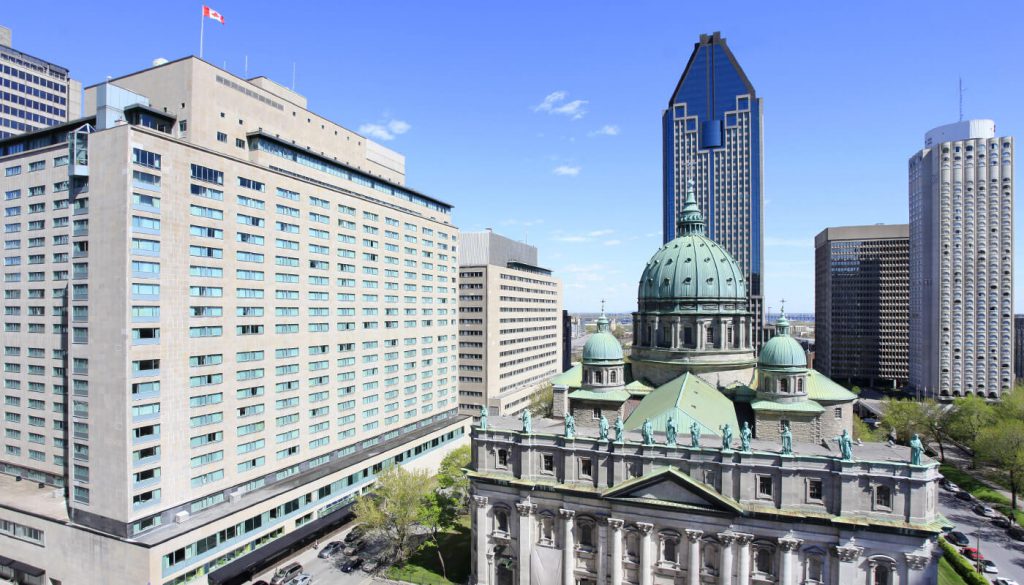
The sustainable way to host
Montreal has been certified as an environmentally sustainable host city for meetings & events. It is a great step forward for the industry, especially as one of North America’s first major cities to move away from plastic and enrich a greener environment. Ideal for organizations that take pride in having a smaller environmental impact. As a part of this project, you can find environmentally friendly building and spaces such as the Centre for Sustainable Development, which is an award-winning convention center, including an eco-friendly rooftop garden. The center itself has a range of meeting and event spaces, standing from small boardrooms for 14-20 attendees through to conference/theatre style rooms for up to 130 attendees.
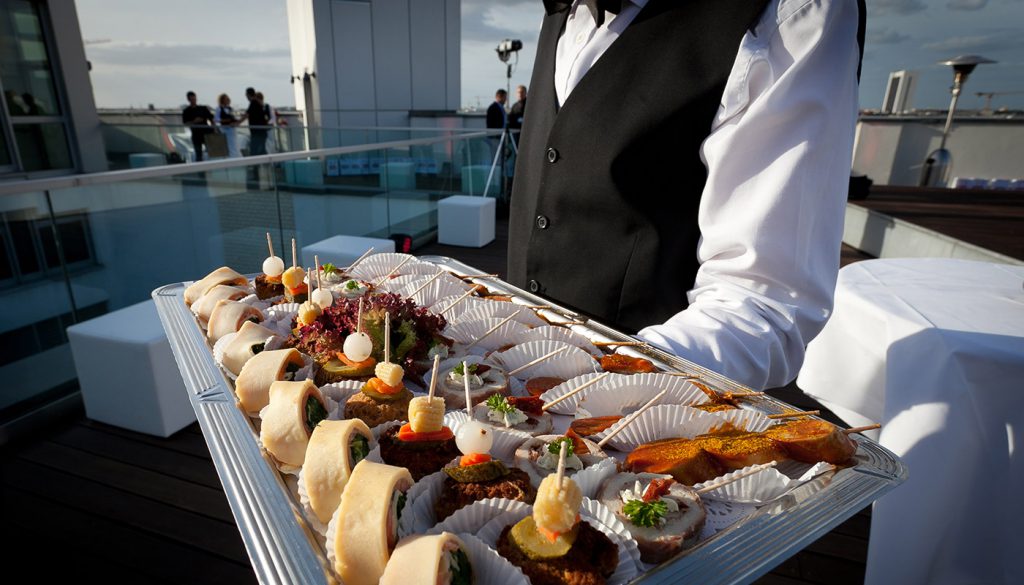
Eat and drink, Montreal style
Montreal is well known for its diverse culture, which is naturally showcased through the variety of restaurants and bars on offer. With Montreal’s French heritage, there is a vast assortment of different French restaurants to pick from. Don’t fret; you will most certainly find everything from traditional fish and chips to the likes of classic European cuisines and dishes for a global flavor.
If you happen to be visiting around early November, you can find the MTLàtable Festival which runs for a series of 10 days. Here you find a series of specially prepared dishes by local restaurants and chefs. It is the perfect opportunity to get a taste of a variety of restaurants, without having to dine at each restaurant individually.
Why not use it as an opportunity to team build with your fellow food-loving colleagues? There is no better way to get to know others than bonding over a food tour or typical Canadian poutine – chips, gravy, and cheese galore!

It’s time to take your meeting or event to Montreal.
Insider insights
Are you visiting Montreal for the first time?
Here are a few must do things:
1. Visit Basilique Notre-Dame
2. Stroll in Plateau Mont-Royal
3. See Montreal from above from Mount Royal Park
4. Discover the Montreal Museum of Fine Arts
5. Get close to nature at Space for Life -

Better hotel data means better travel risk management
And how compliance improves corporate travel safety
Hotel reviews, an invaluable source of data
We all want better data for more accurate reporting, but it also plays an important role in your duty of care.
Working with hotel sourcing consultants, utilizing information from RFPs, and reviewing data from your TMC and security services are a great way of assessing the security of properties, but your own travelers also provide an invaluable source of data.
A great place to get traveler feedback is from hotel reviews. This feedback is important, because on-sight assessments cannot be done for every property and most tools and questionnaires cannot provide the same level of granularity that individuals can.
Safety concerns expressed in reviews are a good cue to begin investigating a property or the surrounding areas. Should a region or property accumulate a lot of low safety reviews, it may be a good idea to take proactive steps such as messaging travelers and finding more visible ways to post safety tips.
If there is an accumulation of safety concerns, it may be a good idea to send a local employee to the property or to do a walkthrough yourself. Next steps could be setting targeted alerts to travelers with itineraries that contain the property or region, or even having your TMC block the hotel from appearing in your corporate tools.
Missing data could mean missing people
This brings us to an important element of duty of care. You are only as effective as your data allows you to be. Should travelers book outside of your corporate booking tools, then you are severely limited, or entirely helpless in supporting them during emergencies.
Many travel managers appreciate the safety concerns associated with direct bookings, but 2/3 of business travelers still don’t even know they are required to book in a corporate tool despite the fact that 8 in 10 businesses require it. This tells us that travel managers need to be better communicators.
Below is a quick overview of 5 actual incidents in 2018 where serious emergencies took place while RoomIt by CWT clients recorded low compliance levels:
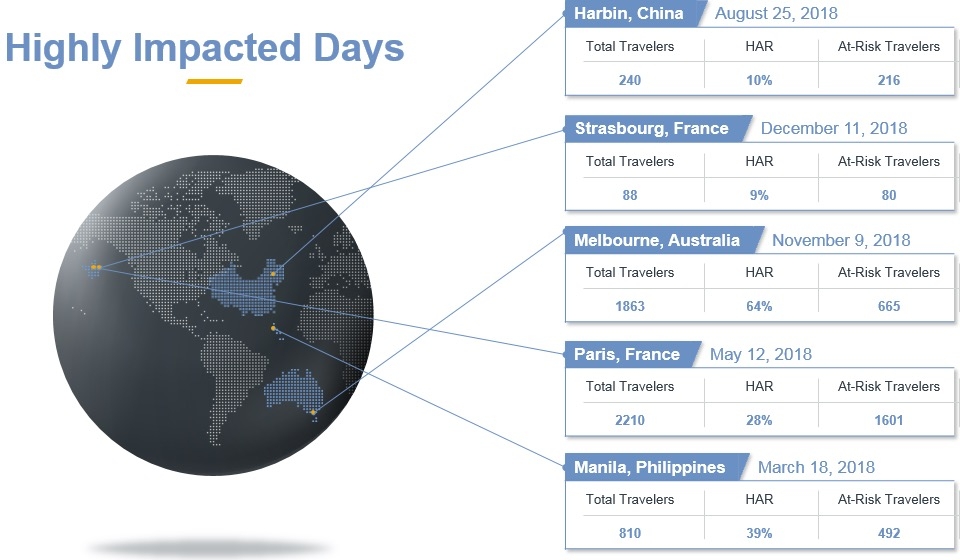
Improving communications can help increase compliance
In the top example, 240 travelers from 14 different RoomIt by CWT clients were in Harbin, China when there was a major hotel fire. The fire ended up killing 19 people and injuring 23 more. Not only that, but the fire took place the day before a marathon, which attracted 30,000 participants and tens of thousands of additional spectators.
Unfortunately, 90% of the 240 travelers did not book through RoomIt, meaning 216 travelers could not be tracked or located during this devastating event. Responding to this incident and helping travelers remain safe is hard enough to do from abroad, assisting them on a high traffic day is even more difficult, but things get exponentially harder when travelers book out of channel. You either have to do a lot of guess work, or you won’t even know if travelers are in the impacted area at all.
There is never a way to guarantee safety for your travelers, so the best thing you can do is to proactively scrutinize as many aspects of safety as possible and to do as much as possible to improve your communications. Security trainings, intranet posts, booking tool posts, emails, blogs, forums, lunch-and-learns, travel fairs, and automated messaging tools are all great ways to pass along safety measures.
Lastly, a safety measure that should factor prominently in your messaging is to book in compliant channels. A request to book “preferred hotels” will not be as impactful as an explanation that booking out of channel (where preferred suppliers are preferenced) can put them in greater danger.
-

Zero discrimination day – 5 tips to fight unconscious biases at work
As a global organization with people from all over the world of different age, gender, sexual orientation, origins, education, work experience, beliefs and many other forms of diversity, we maintain a zero tolerance stance to any forms of discrimination.
It is our responsibility to embrace diversity and promote an inclusive culture in the company. One important step to do that is to identify unconscious biases that can lead us to discrimination.
Everyone can be biased about anything — gender, skin color, age, communication style or what someone does in their free time. Unconscious biases are not intentional — they’re part of the lens through which we see the world. When people don’t fit our perceived expectations, we can sometimes have difficulty seeing the things about them that matter.
Unconscious biases can have a potentially negative effect on recruitment, performance development, retention, leadership and customer experience to name a few examples.
Today, as we celebrate Zero Discrimination Day, here are five tips that we have shared with our teams to help us all avoid bias:
- Question and be curious. Start with yourself. If you notice you are making assumptions without evidence to support them, stop and question where your unconscious bias comes from. Also, pay attention to others. If you feel someone has made a statement that demonstrates an unconscious bias, flag it and be supportive.
- Make meetings inclusive. If you’re a participant, be respectful, limit interruptions, listen to everyone and be constructive. If you’re running the meeting, plan the meeting agenda and who will lead each item, ask for everyone’s opinion and encourage counter opinions.
- Promote supportive dialogue. In order to do so, start by acknowledging — state your understanding without judgment. Then clarify. Ask people to explain their beliefs so that you avoid making any incorrect assumptions. After that, look for evidence, ask for specific examples. Finally, solve; ask people to brainstorm if there could be another solution.
- Avoid bias during recruitment and talent management assessments. Predefine role criteria, required qualifications, technical skills, and job description and then clearly articulate your decision to reject or move forward with each candidate. Use structured interviews and refer to tangible facts to evaluate candidates. Refer to past behaviors and examples instead of relying on your feelings.
- Organize training and awareness sessions to make sure the whole organization works to identify biases and create an inclusive workplace.
- Question and be curious. Start with yourself. If you notice you are making assumptions without evidence to support them, stop and question where your unconscious bias comes from. Also, pay attention to others. If you feel someone has made a statement that demonstrates an unconscious bias, flag it and be supportive.
-

The best metrics for building your hotel program
As hotel programs evolve and become more complex, it becomes more important to have the right data to improve your hotel program.
So, where to begin? In a recent survey with GBTA, travel buyers told us their top goals for their hotel program in 2019. They are to reduce program costs, increase policy compliance and improve traveler satisfaction. Here are three metrics to help you achieve these goals.
- Traveler Satisfaction
According to a study conducted by Sabre, the number one determinant of traveler satisfaction is comfortable and convenient lodging. One way you can ensure you’re delivering properties that meet travelers’ needs is to analyze hotel reviews. If you discover there are properties that are not meeting expectations, you have the ability to challenge your hotel partner or block them from your program. You can also use reviews to understand travelers’ preferences and to determine which properties you want to partner with in the future. - Compliance
Travel buyers told us their top challenge is increasing compliance. Lack of compliance leads to other challenges as well, including collecting and reconciling traveler data from multiple sources, like credit card and expense data.
One efficient way to gauge non-compliance is to track the percentage of air or rail bookings that are accompanied by a hotel booking. If this number is low, investigate why and develop communication strategies to address non-compliance.
That leads us to the reporting that travel buyers told us they want most: why travelers book non-compliant rates. Most booking tools allow reason codes to be applied to bookings of non-preferred properties and non-compliant rates. This information can help you evolve your travel program or policy accordingly.
For example, business travelers told GBTA it is challenging to book hotels within their allowance or near their destination through their corporate tools. If travelers are having difficulty booking your preferred hotels, CWT Solutions Group can help you monitor the availability of your negotiated rates throughout the year to ensure it meets your contract obligations. - Savings
While negotiated rates can drive savings, they don’t come easily. As noted earlier, travel buyers often struggle to collect and reconcile data, which can make it difficult and time-consuming to negotiate the best rates. In fact, CWT Solutions Group found travel buyers spend an average of 400 hours securing rates each year.
To build a more efficient and cost-effective program, many buyers negotiate rates in top cities and rely on other rate sources, like RoomIt Rates, to drive savings for the bulk of their destinations. To optimize your rate mix and savings, you should:
Use the top destination report, which highlights where your travelers have stayed the most, to begin building your hotel program plans. If you do not have enough volume (typically 150+ room nights per year) at a particular property, you may be able to drive more savings through other rate sources.
Next, analyze your rate mix. Our rate mix report compares rates in key destinations, including RoomIt Rates, third-party hotel content (i.e. Booking.com or Expedia Partner Solutions), CWT Programme Rates, public rates, and your negotiated rates.
This report demonstrates how diversifying your rate portfolio can help you save. In cities where you do not have negotiated rates, you can identify which rate types drive more savings than public rates. You can also find savings opportunities in destinations where you have corporate negotiated rates. According to CWT data, corporate negotiated rates are not the lowest available, 25% of the time.
Clear data drives clear results
The information found in hotel reviews, hotel attach rate, top destination reports, and rate mix will paint a very clear picture about the status of your hotel program. From here you’ll be in a great position to build effective and reliable hotel strategies.
- Traveler Satisfaction
-
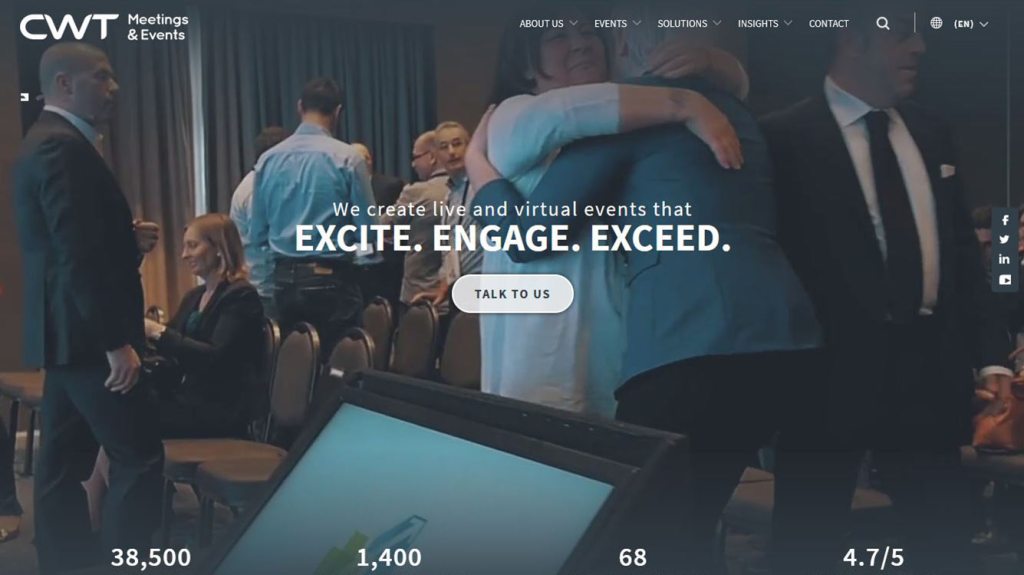
CWT Meetings & Events launches rebrand with fresh logo and new global website
Meetings & Events has launched a rebrand as part of Carlson Wagonlit Travel’s own rebrand, which last week saw it renamed simply as CWT.
At the same time, CWT M&E has unveiled a dynamic new website with brand-new functionality and content, and a fresh new look. The new site showcases CWT M&E’s services, including live events, technology, consulting and creative solutions, and provides a more engaging, intuitive user experience.
“These changes reflect our focus on creativity – combining the power of technology and innovation with the expert know-how of our people to deliver memorable events and experiences all around the world,” said Derek Sharp, SVP and Managing Director of CWT Meetings & Events.
CWT is a leading global partner in business travel, meetings, and events. Operating across six continents, we deliver sustainable, tailored solutions that help organizations connect, engage, and thrive in an evolving world. Our myCWT platform integrates advanced technology with human expertise to simplify travel and enhance traveler and attendee experiences. Extensive global coverage, seamless data integration, AI-driven analytics, and carbon-conscious travel tools enable businesses to optimize their travel and meetings programs while delivering measurable value.
With 150 years of industry experience and a deep commitment to partnership, CWT collaborates with clients to shape the future of business travel and events, making them more efficient, responsible, and impactful.
CWT Meetings & Events
CWT Meetings & Events delivers 38,500 innovative, high-quality projects for customers every year – across all industry sectors, globally. Our creative know-how helps us deliver awe-inspiring events, and our logistics expertise guarantees professional meeting services, group travel, and compliance. We manage your strategic meetings management programs with one aim in mind – to maximize your return on investment.
CWT Meetings & Events is CWT’s meeting & events division. -

Empowered to care – creating opportunities for deeper employee involvement
Last October, we spoke of the values established more than 80 years ago that continue to guide us as corporate citizens tightly woven into the well-being of our communities.
For us, being a good corporate citizen requires not only conducting business responsibly but also fostering the values of community engagement, philanthropy, integrity and leadership among all employees. In short, it is finding and amplifying the sense of caring in our people.
The benefits of this are tremendous for CWT, its customers, and our communities, so we work to provide community involvement and giving programs that welcome and rely on the participation of our employees. With the help of a dedicated Responsible Business Network that spans all geographic regions and business functions of CWT, our colleagues are empowered to develop projects and partnerships that support communities close to their heart and their home.
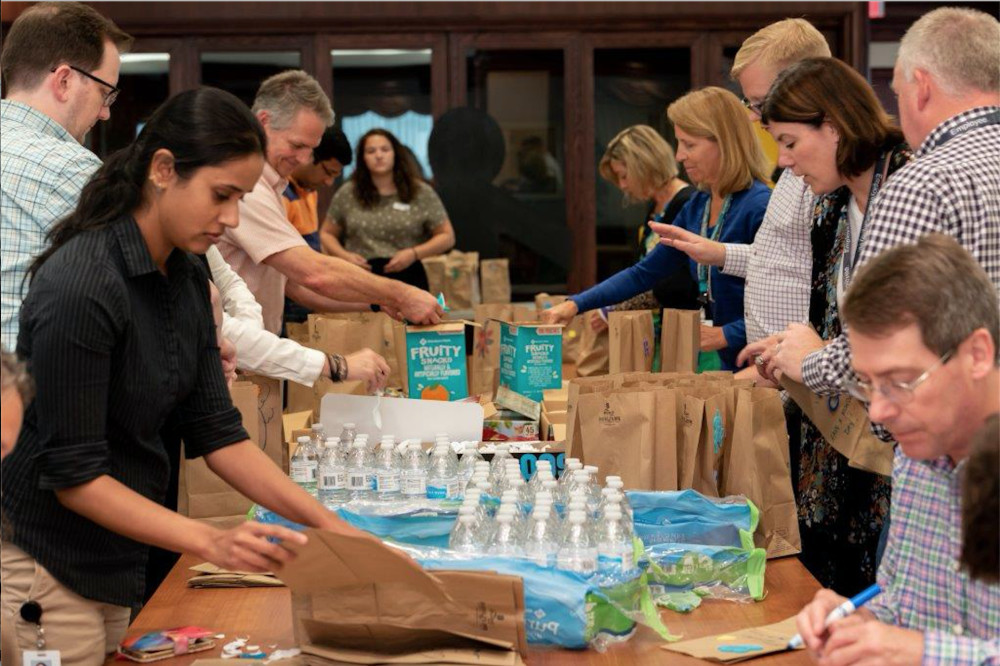
CWT staff assembling care packages for cancer patients undergoing treatment.
One example of this was the 2018 Carlson Community Giving Campaign. Following the outstanding US results, we launched phase two by expanding the campaign globally through the Employee Choice Grant Awards. With support from the Carlson Family Foundation, this program celebrated the 80th Anniversary of Carlson by offering eight US$10,000 grants to local nonprofit and charitable partners recommended by our people across the world.
The response was amazing, as nominations and votes came in from dozens of countries and CWT communities. Stay tuned, as we are excited to soon announce the final recipients of these grants and the important work that they perform in so many of our regions.
CWT is proud of the drive and commitment that our employees show for their communities, and look forward to empowering them further to continue to share our values of corporate citizenship throughout the globe.
